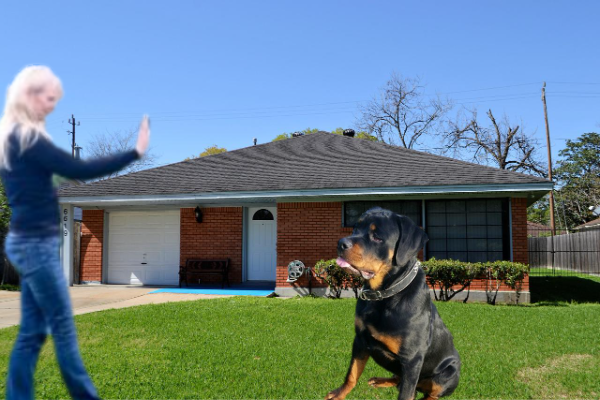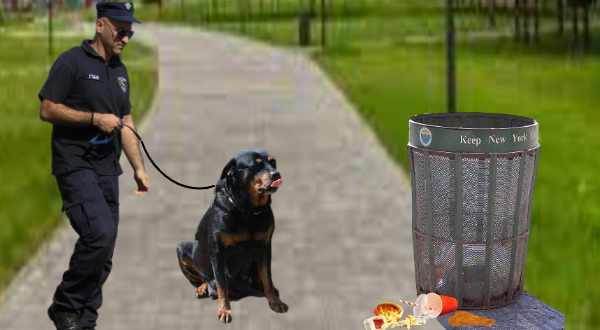How to train a Rottweiler post may contain affiliate links. Learn more on my Affiliate Disclosure page.
Save money and time. This article explains how to obedience train a Rottweiler dog yourself. Read on to learn more about simple do-it-yourself (DIY) dog training here without spending your time and hard-earned money traveling to a professional dog training school across town.
Rottweilers make great family pets when properly trained and socialized. Also, your Rottweiler puppy will be loyal and protective of your children if you raise him around them.
Discover more about Do It Yourself (DIY) Rottweiler dog training here.
Since you won't need to take your dog to a professional trainer's facility, self-training will save you time and money. You can also keep your dog from being confused by receiving behavior commands from different people.
We will show you how to overcome problems you may encounter during certain Rottweiler dog training behaviors.
Rottweilers are easy to train, making them good guardians who are loyal, loving, and confident.

How To Train A Rottweile History
Knowing your dog's history before you begin behavior training is essential. Germans bred Rottweiler, also known as Rotties, to be a working dog.
Molossus, an Italian mastiff-type dog, is thought to be the ancestor of the Rottweiler. Over the Alps, they protected the cattle of the Romans by herding them.
It was common to use Rottweiler dogs as guard dogs, messenger dogs, and herders during the Middle Ages. The Rottweiler takes its name from the German town of Rottweil.
In Germany, Rottweilers drove cattle to towns for butchering. However, there was a time when Rottweilers were almost extinct because rail transport replaced cattle drives.
Since the late 1800s, many dedicated breeders have saved the breed from extinction. Today, their appearance and personality are essentially the same.
Rottweiler Distinguish Characteristics

Rottweiler Dog Characteristics And Temperament
Rottweilers are known to be calm, confident, brave, not timid, and self-assured aloofness, which makes it difficult for them to make friends with new people or situations instantly. They have a wait and see attuited.
Rottweilers will follow their family around the house and often show affection for them.
FAMILY PET COMPATIBILITY
AFFECTIONATE WITH FAMILY (High)
GOOD WITH YOUNG CHILDREN (Above Medium)
GOOD WITH OTHER DOGS (Medium)
PHYSICAL
SHEDDING LEVEL (Medium)
COAT GROOMING FREQUENCY (Low)
DROOLING LEVEL (Above medium)
COAT TYPE (Smooth)
COAT LENGTH (Short)
SOCIAL
OPENNESS TO STRANGERS (Medium)
PLAYFULNESS LEVEL (Above Medium)
WATCHDOG/PROTECTIVE NATURE (High)
ADAPTABILITY LEVEL (Above Medium)
PERSONALITY
TRAINABILITY LEVEL (High)
ENERGY LEVEL (Above Medium)
BARKING LEVEL (Low)
MENTAL STIMULATION NEEDS (High)
You can learn more about the Rottweiler breed at the American Kennel Club, which ranks the breed at 8.
How To Train A Rottweiler Pros and Cons
Would you like to become a Rottweiler parent? Despite being suspicious of strangers, this breed is affectionate and loving towards its family.
When appropriately trained, Rottweilers can achieve high standards. However, it may be challenging for some Rottweiler parents to handle the dog's strong temperament and dominant behavior.
Pros
- Intelligent - Rottweilers appear to be aggressive and assertive dogs but incredibly intelligent. Considering Rottweilers have worked with humans for a long time, they are pretty good at recognizing humans. Their learning abilities are excellent.
- Watchdogs - The Rottweiler has historically served as a guard dog. Among the best guard dog breeds, the Rottweiler is a top choice. It doesn't matter whether it's property or just protecting the family and owner. They are experts at guarding.
- Grooming - In spring and fall, Rottweilers shed heavily. However, they shed moderately the rest of the year. Because Rotties have medium-to-long coats and double layers, many people think they require frequent grooming. However, a lot of grooming isn't necessary.
- Vocal - A Rottweiler may be a good choice if you do not want a noisy dog. Unlike other breeds of dogs, Rottweilers tend to bark only when necessary. A proper socialization program, however, can reduce their tendency to bark at aggressive strangers.
- Energetic - They are also quite agile and active. Rottweilers need hours of exercise daily, so they are an excellent companion for those who love to exercise and work out. The jaws of these animals are powerful, and their bodies are muscular.
- Social - Rottweilers are very friendly and territorial, and protective. Sharing time with someone is always on their mind. Rottweilers do not like to be alone. They enjoy spending time with family members. Many of them may become clingy and follow you everywhere.

- Trainable - Rottweilers have an easy time understanding commands from their dog parents. Rotties also have good attention and activity levels; they can be trained consistently over their lifetime. Keep their training sessions exciting and entertaining.
- Affectionate - Rottweilers love cuddling and kissing their dog parents. They can be highly calm if socialized and trained correctly from a young age. Having been raised with other pets, they can also get along well.
- Playful -Rottweilers are always happy, active, excited, and eager to play. There are few better dogs for comfort and sport than Rottweilers.

- Personality - Rottweilers possess a confident and strong character. Their popularity is primarily due to their looks. They have a beautiful shiny black-tan coat and a muscular body.
Cons
- Health - Rottweilers often suffer from several health problems, including bloat, aortic stenosis, epilepsy, OCPD, entropion, and ectropion. This breed is typical for hip and elbow dysplasia, cruciate ligament rupture, and other bone and joint problems.
- Stubborn - Rottweilers are known to be persistent, but if they are not properly socialized or trained,
- Aggressive - They can become aggressive. Early training and socialization are essential for making a Rottweiler calm and disciplined.
- Shedding - People want dogs that shed less and don't make a mess. These things could be disadvantages or cons for such dog parents.
- Drooling - Drool a lot when they are anticipating food and sleeping.
- Socializing - If you don't train and socialize your dog correctly, you cannot expect them to become calm and friendly.
- Training - Rottweiler parents can only achieve discipline through proper and consistent training.
- Strangers - Usually, Rottweilers do not like strangers much. Poor socialization is the leading cause of such behavior

- Children - Rottweilers should not be left alone with small children. When playing or doing anything, a Rottweiler might unintentionally hurt a child. Dog parents should teach young children how to interact with dogs.
- Living Space - The Rottweiler is a medium-sized to large dog breed with a high energy level. Their house needs a lot of space so they can roam freely. In small spaces, Rotties often bump into objects and can destroy things due to their habit of jumping in excitement.
- Heatstroke - A Rottweiler can suffer from heatstroke in hot weather. Please keep your dog hydrated, avoid exercising in direct sunlight, carry water when you take him out, and keep him in a cool, shady place.
- Alone - Rottweilers are social dogs who always want to be with their family members. As a rule, they don't like being separated or alone and hate being alone. Long periods alone could trigger separation anxiety.
- Anxiety - This could lead to destructive behavior, aggression, barking excessively, whining, and urinating are common. Therefore, always keep your Rottweiler with you or family members if you leave them for long periods.
- Dominant - Unless they have grown up around other dogs and pets, Rottweilers tend to be dominant. Such Rottweilers do not share toys, food, and beds. Socialization and training have failed in most cases.
Bringing A Rottweiler Puppy Home
You have decided to bring a Rottweiler puppy home. Setting up a suitable training environment is an essential first step. Creating a puppy training checklist is the next step.

To train a Rottweiler puppy, follow the simple instructions outlined in this article. After that, it's just a matter of patience, consistency, and spending time with your puppy in a distraction-free training area.
How To Train A Rottweiler Obedience Commands
How to train a Rottweiler in obedience commands is not only about having a pup that obeys you, but it also strengthens the bond between you and your furry companion.
One effective training method that has been proven successful for Rottweilers is positive reinforcement. You can motivate and encourage your Rottweiler to perform desired behaviors by using rewards such as treats or praise.
To teach your Rottweiler the sit command, hold a treat above their head and slowly move it back towards their tail. As their nose follows the treat, their rear end will naturally lower into a sitting position. Reward them with the treat and plenty of verbal praise when fully seated.
When training your Rottweiler to stay, begin by commanding them to sit. Then step backward while holding up your open palm like a stop sign. If they remain sitting without moving towards you, instantly offer praise and a reward.
Gradually increase the distance between yourself and your Rottweiler as they become more proficient in staying put.
To train your Rottweiler to come when called:
Start at close range within a controlled environment like a backyard or living room.
Use an enthusiastic tone of voice and call out their name followed by come.
When they respond promptly by coming towards you, lavish them with praise or give them a treat as motivation.
As your dog obeys your behavior command correctly, you reward him instantly with treats, affection, or playthings.

How To Train A Rottweiler The Below Obedience Commands Examples
SIT ~ DOWN ~ STAY ~ COME ~ HEEL ~ STOP JUMPING ~ LEAVE IT
It is always advisable for a DIY dog trainer, especially a first-time trainer, to teach Sit first because it is the most intuitive and effortless behavior for dogs to learn.

SIT - It is best to start with "sit" since you can calm your Rottweiler. In addition, it makes teaching other commands easier.

Stay - prevents your dog from getting into mischief and keeps them safe.

Come - Keep your dog safe off-leash by preventing them from mischief.

Heel - Your dog should walk calmly at your side, especially in crowded places.

STOP JUMPING - Keeps your dog from jumping on people and climbing onto furniture.

Leave it - This will prevent your dog from picking up potentially harmful food or objects.
How To Train A Rottweiler Training Equipment
How To Train A Rottweiler By Selecting The Best Crate
Rottweilers are big and strong, so finding a sturdy and spacious crate that can withstand their power is essential.
- Look for crates made of heavy-duty materials like metal or reinforced plastic.
- Once you have the perfect crate, it's time to introduce your Rottweiler to their new den.
- Start by placing the crate in a calm, quiet area of your home where your pup feels safe.
- Place some soft bedding inside the crate to make it cozy and inviting. You can also put a few treats or toys inside to entice them further.
Now comes the fun part—getting your Rottweiler acquainted with their new space.
- Encourage your pup to explore by leaving the door open and enticing them with treats or toys placed just inside the crate's entrance.
- Allow them to enter at their own pace, never forcing or pushing them in.
With patience and consistency, your Rottweiler will start associating positive experiences with their crate.
- Gradually increase their time inside, rewarding good behavior with praise or treats.
- Remember that training takes time, so be patient and persistent. Before long, your Rottweiler will view their crate as a haven—a place they willingly retreat to when seeking comfort or solitude
You can place a chew toy or bed inside the crate to make your Rottweiler comfortable.
Dog crates are practical training tools that will prevent your Rottweiler from mischief.
A crate should be a happy and comfortable place. Rottweilers can be fed, watered, and given snacks in their crates.

Potty Training A Rottweiler Puppy
When it comes to potty training a Rottweiler puppy, consistency is vital.
- Establish a designated outdoor spot where your puppy can do their business.
- Take them to this spot after meals and naps, and praise them when they go to the right place.
- To make the process even more effective, use verbal cues such as “Go potty!” or Do your business! The exact words will help them associate those words with the action of going outside.
- In addition to verbal cues, timing is crucial in potty training your Rottweiler.
- Please pay attention to their behavior and note how long it has been since they last went out.
- Most puppies can hold their bladder for an hour per month of age, so keep this in mind when establishing a routine and setting expectations for your furry friend.
- Remember that accidents are bound to happen during the learning process.
- Instead of scolding or punishing your puppy for their mistakes, redirect their focus without fussing.
- Clean up any mess calmly and thoroughly using pet-friendly cleaning products to remove any lingering scent that may encourage further accidents indoors.
By remaining committed, patient, and consistent throughout the potty training process with positive reinforcement rather than punishment, you will soon have a well-trained Rottweiler ready to conquer the great outdoors!
How To Train A Rottweiler Socialize Training
It would help if you began socializing with them as soon as possible and introducing them gradually to a variety of situations, such as:
- People
- Dogs and various animals
- Different locations
- Various situations
- Noises that could be frightening
- Activities and appliances in the household
- “Dog life” routines like baths and being alone at home
To socialize your Rottweiler puppy, you can't simply let him run loose in the dog park or puppy school, and these are some of the worst places.
Developing your puppy's skills will help him understand acceptable behavior in every situation.
How To Train A Rottweiler Accessories
How To Train A Rottweiler Toys
Need Training Help For Your Rottweiler?
Do you need help in training your furry friend? Then, sign up for this fantastic (and free) online workshop on how to train a Rottweiler to become as well-behaved as a service dog.
K9 Training Institute Free Workshop
The K9 Training Institute offers a free workshop where you can learn firsthand their effective training methods.
The Free Workshop emphasizes building a solid bond between you and your pup. They explain how to apply positive reinforcement techniques that make learning enjoyable for dogs and their owners.
Does your dog tug on its leash, bark constantly, and won't come when called? Sign Up and get the FREE Obedience Training Workshop Now!
How To Obedience Train A Rottweiler Yourself Successfully
If you like large dogs, check the article The Bernese Mountain Dog.

Click on the breed titles below for other dog training articles:























